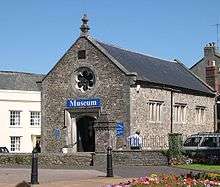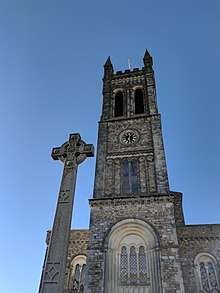Honiton
Honiton (/ˈhʌnitən/ or /ˈhɒnitən/) is a market town and civil parish in East Devon, situated close to the River Otter, 17 miles (27 km) north east of Exeter in the county of Devon. Honiton has a population estimated at 11,822[1] (based on mid-year estimates for the two Honiton Wards in 2009).
| Honiton | |
|---|---|
 Honiton | |
 Honiton Location within Devon | |
| Population | 11,822 (2009)[1] |
| OS grid reference | ST164004 |
| Civil parish |
|
| District | |
| Shire county | |
| Region | |
| Country | England |
| Sovereign state | United Kingdom |
| Post town | HONITON |
| Postcode district | EX14 |
| Dialling code | 01404 |
| Police | Devon and Cornwall |
| Fire | Devon and Somerset |
| Ambulance | South Western |
| UK Parliament | |
History
The town grew along the line of the Fosse Way, the ancient Roman road linking Exeter (Isca Dumnoniorum) to Lincoln (Lindum) on which it was an important stopping point. The location is mentioned in the Domesday Book as Honetone, meaning Huna's tun or farmstead.[2]
Lace-making
Honiton later grew to become an important market town, known for lace making that was introduced by Flemish immigrants in the Elizabethan era. In the 17th century thousands of people produced lace by hand in their homes, and in the 19th century Queen Victoria had her wedding dress made of Honiton lace, though the dress itself was made in the fishing village of Beer.[3] The town also became known for its pottery.[4]
Landmarks

The buildings of High Street are almost all Georgian, dating from after the two fires of 1747 and 1765. Of particular interest are Marwood House, 1619, and the Manor House, which was originally a coaching inn (the added porch is 19th-century). Honiton Garage dates from about 1700 and the Market Hall (which originally had arcades on the ground floor and an assembly room above) has a modest early-19th-century stone front.[7]
Churches

St Michael's Parish Church, which was rebuilt in 1911 after a fire, is situated on a small hill above the town. The old church was large and perfectly rectangular: it was built in the Perpendicular style, with two aisles, two transepts (which did not project), and the chancel and two chancel chapels equal to it in length. The west tower and the outer walls are all that remains of the old building. The cost of the original building was paid by Bishop Courtenay of Exeter, lord of the manor of Honiton (west part) and by John and Joan Takell (east part).[7]
The mid-19th-century St Paul's Church was designed by Charles Fowler and is situated in the centre of the town. Its erection in 1835 required an act of Parliament[8] and the demolition of half of the adjacent Allhallows Chapel. It was built in 1837–38 in a style incorporating elements of Romanesque architecture. There are pinnacles on the tower and the arcades inside have tall columns; above the nave is a clerestory which resembles those in early Christian basilicas.[9]
Museum
Allhallows Museum of Lace and Local Antiquities claims to hold one of the most comprehensive collections of Honiton lace in the world. It is located in a building, claimed to be the oldest still extant in Honiton, which formerly belonged to Allhallows School from the 16th Century until the 1930s.[10]
Culture
Hot Pennies ceremony
The Hot Pennies ceremony takes place annually on the first Tuesday after 19 July in the High Street of the town, and dates back to the reign of King Stephen. The ceremony has its roots in the practice of landed gentry taking pleasure in throwing hot pennies from windows to local peasants, a seemingly philanthropic gesture resulting in burns. The custom also had the purpose of encouraging people to travel to the town from the surrounding area to attend a subsequent fair.[11]
At noon, the Town Crier, accompanied by the Mayor and other local dignitaries, raises a garlanded pole with gloved hand at the top, and proclaims that "The glove is up. No man may be arrested until the glove is taken down.". Hot pennies are then thrown from a number of balconies in the High Street to crowds of local people. The pole is then kept on display for the following "fair week". The children of Honiton Community College are allowed off campus for the duration of the Hot Pennies Ceremony itself.[12][13][14]
Education
Honiton has two primary schools, Honiton Primary School[17] and Littletown Primary School,[18] as well as a secondary school, Honiton Community College,[19] which includes a sixth form.
Transport
Road
Honiton is at the junction of the A35, the A30 and the A373 roads. The A30 now bypasses the town to the north. Until the bypass's construction in 1966, the town was blighted by traffic congestion. Though, according to many residents, it still is. The town is 10.5 miles from Junction 28 of the M5.[20]
Rail
Honiton railway station is on the West of England Main Line and is served by South Western Railway services to London Waterloo and Exeter St Davids.
Air
Honiton is around 13 miles from Exeter Airport.
Twin towns
Honiton is twinned with Mézidon-Canon in France, and Gronau (Leine) in Germany.[21]
Notable residents
- Rose Dugdale
- Samuel Graves: Admiral of the Royal Navy
- Ozias Humphry: Artist
- Alfred Leyman: Artist
- Jo Pavey: Athlete
- William Salter: Artist
- Maurice Edgar Setters: Professional footballer
- George Blagdon Westcott: Captain of the Royal Navy
References
- "Ward mid-year population estimates for England and Wales (experimental)". Office for National Statistics. p. 1. Retrieved 6 November 2010.
- Poulton-Smith, Anthony (15 April 2010). South Devon Place Names. Amberley Publishing Limited. p. 72. ISBN 978-1-4456-3098-4.
- Moore, N.H. (1937). The Lace Book. Рипол Классик. p. 311. ISBN 978-5-87721-817-8.
- Heptinstall, Simon (2008). Devon. Crimson Publishing. p. 96. ISBN 978-1-85458-426-7.
- Fisher, Lois H. (March 1980). A literary gazetteer of England. McGraw-Hill. p. 273.
- AA traveler's color guide to Britain. Automobile Association, Random House Value Publishing. 13 November 1985. p. 17. ISBN 978-0-517-49298-7.
- Pevsner, N. (1952) South Devon. Harmondsworth: Penguin; pp. 181–83
- Kelly (1902). Kelly's directory. Archived from the original on 3 March 2016. Retrieved 16 January 2020.
- Pevsner, N. (1952) South Devon. Harmondsworth: Penguin; p. 183
- Museums, Devon. "Allhallows Museum - Museums in HONITON". Devon Museums. Retrieved 8 October 2017.
- Honiton (2010). Honiton – A Glimpse Back, T Darrant.
- "Hot Pennies Day". Honiton Council. Retrieved 6 July 2016.
- "Honiton's hot pennies - how the tradition started". ITV. Retrieved 6 July 2016.
- "Honiton". Devon County Council. Archived from the original on 26 August 2016. Retrieved 6 July 2016.
- "Honiton Show". www.honitonshow.co.uk. Retrieved 8 October 2017.
- Great Britain. Lands Tribunal (1954). A Selected List of Lands Tribunal Rating Appeals. Rating and Valuation Association. p. 60.
- Honiton Primary School
- Littletown Primary School
- Honiton Community College
- Honiton, Devon, UK to Station Rd/A373 – Google Maps. Maps.google.co.uk (1 January 1970). Retrieved on 22 May 2012.
- Honiton Twinning Association | Honiton Town Council. honiton.gov.uk. Retrieved on 16 April 2013.
External links
| Wikisource has the text of the 1905 New International Encyclopedia article Honiton. |
| Wikimedia Commons has media related to Honiton. |
